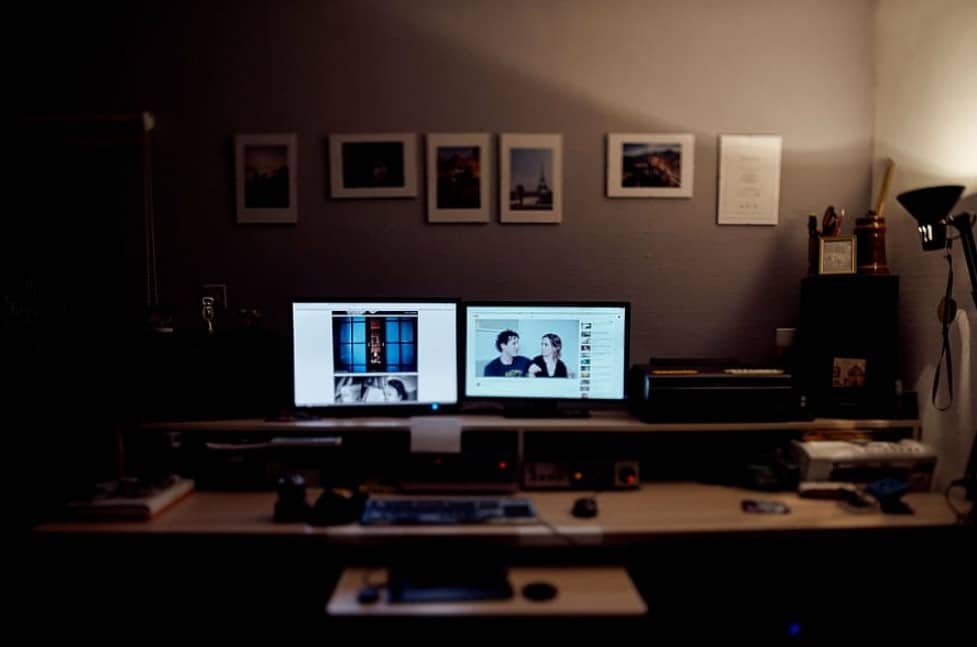Table of Contents
Is 1440p Worth It? Most gamers are familiar with resolutions and refresh rates. If you aren’t, then you should know that the standard aspect ratio for monitors is 16:9 and 1440p is the next step up from 1080p in that aspect ratio. 1080p is also called Full HD, so 1440p is one step up from Full HD, but isn’t quite up to the quality of 3k or 4k resolutions. Below I’ll discuss in-depth the pros and cons of a 1440p monitor and whether it really is worth getting.
Key Takeaways
- A 1440p resolution gives you a higher image quality than 1080p or full HD
- If you are a gamer or a gaming developer, then a 144Hz 1440p monitor is exactly what you are looking for
- Big 3 specifications for monitors are refresh rate, response time and resolution
- 1440p monitors are going to be more expensive than 1080p monitors
When Was 1440p Invented?
Users first started 1440p computer displays in 2010. In that year, Dell's Ultrasharp U2711 was released as a WQHD (Wide Quad HD) with a 1440p screen. Later, Apple released their 27 inches Apple LED cinema display, which also features a 2560 × 1440 resolution.
In September 2020, Microsoft revealed that their Xbox Series S could support the QHD resolution at 120 FPS.
By 2020 the QHD resolution has become very popular in the PC gaming world, with many graphics cards that support it. In addition, early in 2021, many computer manufacturers introduced 1440p gaming laptops at a user-friendly price.
Is 1440p Worth It?
1440 pixel is also referred to as Quad HD or 2K resolution monitor. Whether or not you should get a 1440p resolution monitor depends a lot on what kind of equipment you are working with. Your Graphics Processing Unit (GPU) determines what kind of graphical quality your machine can handle, so if your GPU can’t handle resolutions higher than 1080p then you definitely shouldn’t be getting a 1440p screen. If you have a monster GPU and you are looking for a new gaming monitor then 1440p may be worth picking up.
Before the costly upgrade, most folks are wondering how to use laptop as monitor before footing the bill for a 1440p unit.
Resolution isn’t as important as other specs when it comes to PC gaming. What you are really after is a fast response time and a high framerate, the higher resolutions are just icing on the cake. If you can find a 1440p 144hz monitor with a fast response time and your GPU can handle that resolution then it would certainly be a good idea to pick it up.
If the GPU you already have isn’t good enough, you have to tack on the price difference of a decent gaming GPU on top of the monitor’s cost, which will get extremely expensive very quickly. In this circumstance it probably isn’t a good idea to be going for a 1440p screen.
Really, what determines whether a 1440p screen will be worth buying is how much value you place on image quality over performance. In truth, if you are considering 1440p vs 1080p then you should know that a 1080p monitor is more than sufficient for most gaming purposes. I have been using a 1080p monitor for 6 years and have had no problems running games I play.
That said, a 1440p screen will certainly look better than a 1080p monitor, there is no denying that. High resolutions result in higher image quality which means your pretty games on 1080p will look even prettier on 1440p.
If you are considering a 1440p vs 4k situation, then you have to realize that 4k monitors are much bigger than 1440p monitors are. If you don’t have the space for an absolutely gargantuan monitor on your desk then a 1440pl screen is definitely the better route to go with.
The Advantages of 1440p
I’ve talked a lot about “p this” and “p that”, but what even does p stand for and what resolution is 1440p? Well, the p stands for “pixel” which is the unit of measurement for resolutions and 1440p is the common name for a 2160 x 1440 resolution size.
A 1440p resolution gives you a higher image quality than 1080p or full HD which naturally makes it an excellent choice for those people that place a lot of value on how their games look. That is certainly a fair perspective, especially for those gamers that prefer the single-player experience. The performance of your monitor matters less for non-competitive gaming and the graphical quality matters more. Also, before you buy, you may want to know if 1440p 4K is resolution. With more gamers looking to adopt 4K, 1440p is currently the sweet spot for gamers.

You also have to consider that a 1440p monitor provides a better image quality in an overall similar size and weight range to a 1080 pixel monitor so you don’t have to deal with as much wobbling or risk of tipping as you would with a massive 4k monitor. If you are operating in a small location, like I do, then a bigger monitor is more of a detriment than a help.
Something else worth noting is that the specs you are going to find on monitors will often change based on their display panel type. TN displays will have faster response times, IPS panels will look prettier but perform slower, and VA types will have less in the way of weaknesses but won’t perform as well as either in their respective specialties. Click here to learn more about TN vs IPS.
I don’t have a lot of space for all of my computer equipment, which means I need a monitor that isn’t going to take up so much room that there’s no place for my speakers or my input devices. If you are in the same situation, but you are still looking for an upgrade, then 1440p is a great choice.
Why Get 1440p Monitor That Run at 144Hz
A 144hz 1440p monitor is a display that has been specifically designed for great gaming experience. If you are a gamer or a gaming developer, then this is exactly the monitor you are looking for, provided it also has a fast response time.
Refresh rates determine how many times per second your monitor will refresh the images on your display. This is comparable to framerate and the two are often discussed together. This is because, for gaming, you want your refresh rates and your framerate to be as close together as possible, and as high as possible. The closer your refresh rates is to being the same as your frame rate, the smoother the game will look and the less screen tearing or graphical artifacts you will experience.
144 Hz is the ideal refresh rates for gaming as long as your GPU is powerful enough to match that framerate, otherwise you will have to lower the refresh rates to be comparable to your acceptable framerate which means you aren’t using your monitor to its fullest potential.

This doesn’t necessarily mean you shouldn’t get a 144hz 1440p display, though, because there is something to be said for futureproofing. Computers are expensive, which means it is best to upgrade them in stages. You might be able to afford the monitor now, and then you can get the upgraded GPU later to make full use of your monitor.
Remember though, that resolution is the least important of the big 3 specifications you should be looking at for gaming monitors. The most important thing is the response time followed closely by the refresh rate. You want a response time that is less than 5 milliseconds and a refresh rate of 144 Hz or as close as you can get to it.
There are monitors out there that can operate at even higher refresh rates like 165 Hz, but unless you have an extremely powerful machine they aren’t worth getting.
The Cost of Gaming At 1440p
A 1440p monitor 144hz refresh rates with a fast response time is going to be expensive. Prohibitively so, in some cases. What you are really weighing here is the value of performance vs aesthetic. 1440p resolutions look nicer, a lot nicer, but they require more powerful equipment which will cost a lot more money if you aren’t willing to sacrifice performance.
You could, theoretically, grab a 1440p monitor with a refresh rates of 60 Hz and a response time of 5 milliseconds and be able to game on it, but despite the higher image quality it still won’t perform as well as a 1080 pixel monitor with 144 Hz refresh rates and a 1 millisecond response time for the same price.
You have to decide what is more important to you. This can largely depend upon what kind of games you are playing. If you play less demanding games that are less competitive, or even non-competitive like Dragon Age then the increase in image quality will probably be worth the loss in performance, but if you are a very competitive Rainbow Six Siege player then the image quality won’t be as important as making sure your enemies don’t have an advantage over you because of their equipment.
You also can’t consider a monitor purely on its own merits when it comes to cost. Sure, a 1440p monitor sounds nice and looks like it could be affordable by itself, but if you are using a rinky-dink little GTX 960 graphics card (see best external graphics card), there isn’t much point in getting such a high-quality monitor. You’ll be having a hard time keeping up a 60 Hz refresh rates at 1080p, let alone 1440p. So you have to consider the cost of increasing the quality of all of your equipment, not just the monitor.
More Demanding Games Will Require More Expensive Hardware
So, I made mention of more demanding games like Rainbow Six Siege and Dragon Age, but that doesn’t tell you much about which games require what kind of equipment, so let’s delve a little deeper into that subject.
I am an RPG player. I love a good story and those are most often found in RPG games which means I’m more familiar with that style of game and what kind of equipment you need for it. That said, I’ve been known to dabble in playing games like Siege or Gears of War and I can say that the two require that you consider different specifications when you are looking into your equipment.
An RPG or a Turn-based Strategy game isn’t going to require much in the way of rapid response times or a super high refresh rate. Really, you just need a response time that is comfortable, something that isn’t going to give you too much input lag. These demanding games certainly benefit from higher refresh rates, but you can still get the most from your gaming experience with 60 Hz just fine.
Resolution is going to matter a lot more here than it does for other game types, because the higher your resolution is the crisper the images will be and the higher your field of view can be without it feeling awkward.
For more competitive gamers, fast-paced games like Shooters and Fighting games response times are king. You don’t want to settle for anything less than a 1 millisecond response times. For fighting games especially, the refresh rate is important. You don’t want to be seeing as many frames as possible because 1 or 2 skipped frames could be the huge difference between victory and defeat.
If you are more of a racing game enthusiast then the screen size of your monitor matters more than these other specifications. The wider your monitor the more immersive your experience and the more you can see.
The Tradeoffs of Higher Refresh Rate Monitor or Higher Resolution Monitor?
You can save yourself a lot of money by deciding to make some sacrifices in one area to get improved performance in another. Deciding whether a higher resolution or a higher refresh rate is more important to you means that you can save possibly a hundred dollars or more on your purchase.
1080p monitors are going to be cheaper than 1440p monitors. So, if you care more about the refresh rate then you might consider going with a 1080 pixel screen with 144 Hz instead of the 1440p with 60 Hz. Or you could decide the other way around, but either way, going with one of those options is going to be a lot cheaper than trying to get a 144hz 1440p display.
So, Is 1440p screen Worth It? If you read the section before this then you know that one specification can be more important than the other based on what kind of games you play, so maybe that will help you make the decision, but ultimately it can’t be decided for you. If you want to get the perfect monitor for you specifically then you’ll have to make the decision yourself based on what you know about your equipment, your budget, and your priorities.
Usage of 1440p Resolution
The most common gadgets to find 1440p Resolutions are smartphones and laptops. It is amongst the most popularly used resolutions in computer games. Luckily, the costs of 1440p laptops are budget-friendly.
These days, most gaming consoles have started using 1440p. For example, Xbox One S and PS4 Pro have increased their compatibility with 4K and 1440p.
Making 1440p Work For You
Future belongs to 4K. But whereas 1080p is getting older and 2160p is on the cutting edge, 1440p is perfect for the technology that exists right now. It’s easy to get it working on almost any platform, and your frame rate won’t suffer for it. Thought it might not be as future-proof as 4K, it’s not too small for your big screen, not too expensive and hard to work with.
FAQs:
1. Is 1440p really better than 1080p?
From our personal experience in the comparison of 1080p vs 1440p, we can conclude that 1440p is better to 1080p because it provides a larger screen surface workspace footprint, greater image definition sharpness accuracy, and more screen real estate. A 32-inch 1440p screen is equivalent in "sharpness" to a 24-inch 1080 pixel monitor.
2. Is 1440p worth it for productivity?
1440p is definitely worth it for productivity. The extra screen real estate makes it easier to see more of your work at once, which can help you be more productive.
3. How much bigger is 1440p than 1080p?
Because 4k resolution has better pixel density, it provides more detail than 1440p. The resolution of a monitor is determined by the width and height in pixels. A 1440p signifies a width of 2560 pixels and a height of 1440 pixels. The width of the 4k resolution image is 3860 pixels, and the height is 2160 pixels.
4. Can you tell the difference between 1440p and 4K?
4K is a higher resolution than 1440p. 4K has a resolution of 3840x2160, while 1440p has a resolution of 2560x1440. This means that 4K has over four times the resolution of 1440p. This can be seen when viewing images or videos on a screen. 4K will have more detail and be sharper than 1440p.


